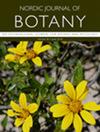亚麻荠属(芸苔科,苔科)的复活引进一个新物种
IF 1.1
4区 生物学
Q3 PLANT SCIENCES
引用次数: 0
摘要
双典型属Camelinopsis最近被归入pseudoamelina。然而,我们在此表明Camelinopsis campylopoda属的模式种与pseudoamelina不同,应该被视为一个单独的属。第二种C. kurdica属于pseudoamelina属。Camelinopsis与pseudoamelina的区别主要在于其近球形到宽倒卵形,略扁的硅片宽1.8-2.6 mm,而不是线性的,窄椭球,偶尔长圆形到倒卵形的硅片,其宽度从不超过1.5 mm。此外,Camelinopsis的种子在湿润时具有粘液性,而pseudoamelina的种子则没有。根据伊朗北部Alborz山脉西部的新标本,描述和说明了一个新的Camelinopsis种。这种新植物,C. alborzica,很容易与C. campylopoda区分开来,因为它两年生(一年生)的习性,直的(强弯曲的)总状花序,较长的萼片(1.7-2.1毫米对1.2-1.5毫米),较短的果梗(0.5-1厘米对1.5 - 4厘米)和较高的胚珠数(每个子房8个对4个)。Camelinopsis属被认为是高海拔Didymophysa属的低山亲戚,正如ITS系统发育所表明的那样。本文章由计算机程序翻译,如有差异,请以英文原文为准。
Resurrection of the genus Camelinopsis (Brassicaceae, tribe Thlaspideae); with introduction of a new species
The ditypic genus Camelinopsis was recently subsumed into Pseudocamelina . However, we here show that the type species of the genus, Camelinopsis campylopoda is distinct from Pseudocamelina , and should be recognized as a separate genus. The second species C. kurdica , however belongs to the genus Pseudocamelina . Camelinopsis differs from Pseudocamelina mainly by its subglobose to broadly obovoid, slightly flattened silicle which is 1.8–2.6 mm wide, instead of a linear, narrowly ellipsoid, occasionally oblong to obovoid silique, that is never wider than 1.5 mm. In addition, seeds of Camelinopsis are mucilaginous when wetted while seeds of Pseudocamelina are not. A new species of Camelinopsis is also described and illustrated based on new collections from western Alborz Mountains, northern Iran. This novelty, C. alborzica , is readily distinguished from C. campylopoda by its biennial (versus annual) habit, straight (versus strongly flexuous) racemes, longer sepals (1.7–2.1 versus 1.2–1.5 mm), shorter fruiting pedicels (0.5–1 versus 1.5– 4 cm) and higher ovule number (8 versus 4 per ovary). The genus Camelinopsis is considered a low mountain relative of the high‐elevation genus Didymophysa , as indicated by an ITS phylogeny.
求助全文
通过发布文献求助,成功后即可免费获取论文全文。
去求助
来源期刊

Nordic Journal of Botany
生物-植物科学
CiteScore
1.90
自引率
11.10%
发文量
100
审稿时长
2 months
期刊介绍:
Nordic Journal of Botany publishes original contributions on all aspects of the taxonomy, evolution, conservation, ecology and biogeography of plants (including algae and bryophytes) and fungi.
 求助内容:
求助内容: 应助结果提醒方式:
应助结果提醒方式:


